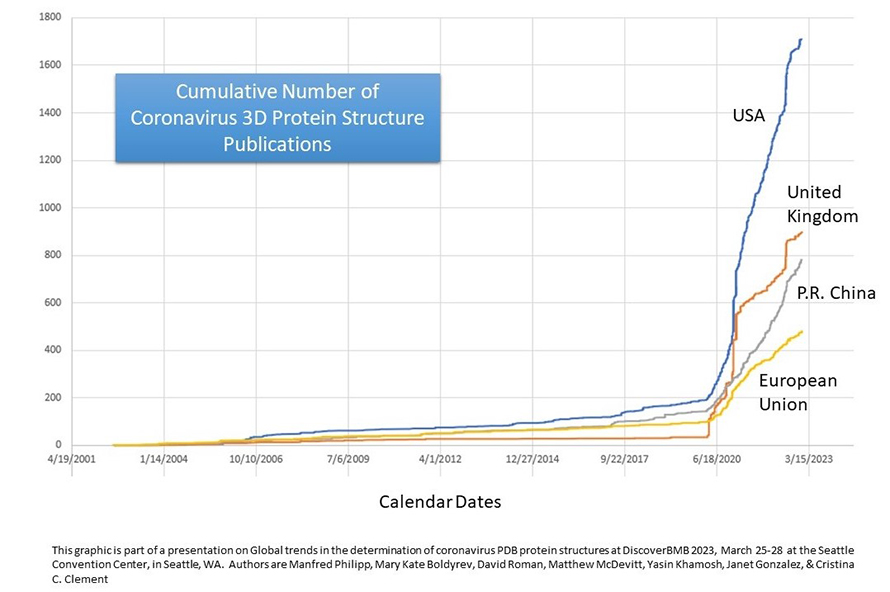Global analysis of coronavirus protein research reveals how countries respond to disease
In a new study, researchers examined how a country’s number of published 3D protein structures for coronaviruses, including the one responsible for COVID-19, correlated with its economic output and population. The findings reveal important insights into how different countries' research establishments respond to disease outbreaks and could be useful for planning responses to future pandemics.
The study showed that countries with larger economies generated more 3D structure determinations for the protein components of coronaviruses, although there were many outliers. For example, some advanced and prosperous countries published few or no coronavirus structures while some countries strongly affected by COVID-19 published far more such structures than would be expected based on their populations and economies.
Manfred Philipp, professor emeritus at the City University of New York, will present the new research at Discover BMB, the annual meeting of the American Society for Biochemistry and Molecular Biology, March 25–28 in Seattle.
The 3D structures of proteins, such as those that make up coronaviruses, are determined using techniques such as X-ray crystallography and nuclear magnetic resonance. This information is then deposited into the Protein Data Bank (PDB) database so that it can be used to develop new drug treatments and new vaccines. Protein structure information is also key for understanding how viruses infect cells and interact with our immune system.
“We asked ourselves how different countries respond to disease, not in terms of treatment and medical care, but in terms of the research needed to study those diseases and to develop new treatments,” said Philipp. “Structure determinations provide a clear metric in terms of research response without any vagaries of interpretation.”

Although a great deal of research has examined levels of coronavirus research funding in various countries, most of this work has focused either on coronavirus-related patents or financial inputs. However, relating research to patents is complex, in part, because some nonprofits perform considerable amounts of research but rarely apply for patents while some patent-generating organizations don’t conduct a lot of research. Financial-based analyses don’t provide a complete picture because it is difficult to capture both public and private funds. Also, private research funds are not always publicly disclosed and some funds that are reported may be used for administrative and overhead costs instead of directly for research.
“Because we did not look at levels research funding, we didn’t have to figure out how much research funding was devoted to disease and how much to something else,” said Philipp. “Our metric only sees research successes and provides a clear indication of the amount of research applied to this topic alone.”
In the work, the researchers collected and cataloged 3D structure determinations for all proteins and nucleic acids that are components of coronaviruses. This included viruses from animal infections as well as those responsible for the 2003 SARS epidemic in Asia, the 2012 MERS epidemic in the Middle East, the worldwide COVID-19 pandemic and other coronaviruses that have been studied.
Of the approximately 40 countries the researchers examined, the United States, United Kingdom and China had the highest number of protein structures. They found that population size contributed very little to the number of coronavirus protein deposits while countries with a higher GDP did tend to deposit more protein structures. The number of confirmed COVID-19 cases was positively associated with the number of PDB deposits per country, especially in the U.S. Although South Africa and Brazil are not in the top 10 research-producing countries, they had a high number of COVID-19 cases and PDB deposits, suggesting that the high number of cases experienced in these countries influenced their research output.
“Our research on the country distribution of coronavirus-related structure determinations is intended to give research administrators in various countries the tools to redirect research funds in the most productive direction,” said Philipp. “For example, it can help countries with large research budgets but few if any structure determinations to redirect the focus of their research. This should not be the only such metric, but it is a key metric since it is independent of administrative and overhead costs.”
Next, the researchers plan to examine whether the number of structure publications for coronaviruses will continue to increase as the COVID-19 pandemic subsides and whether the countries that have led in depositing coronavirus structures into the PDB will continue to lead.
Manfred Philipp will present this research from 4:30–6:30 p.m. PDT on Sunday, March 26, in Exhibit Hall 4AB of the Seattle Convention Center (Poster Board No. 177) (abstract). Contact the media team for more information or to obtain a free press pass to attend the meeting.
Enjoy reading ASBMB Today?
Become a member to receive the print edition four times a year and the digital edition weekly.
Learn moreGet the latest from ASBMB Today
Enter your email address, and we’ll send you a weekly email with recent articles, interviews and more.
Latest in Science
Science highlights or most popular articles

Plants get a GMO glow-up
Lose the prickles. Add bioluminescence. Up the nutrients without the bitter flavor. CRISPR gene editing is opening a new world of genetically modified plants for home growers.

Bananapocalypse – the tricky genetics of a devastating fungus
Fusarium oxysporum can infect over 120 plant species. Whether it destroys Cavendish bananas as it did their predecessor depends on the agricultural industry and consumers.

From the journals: MCP
Young proteins are more likely to be degraded. Full automation speeds up sample preparation. Proteomics sheds light on cancer immune suppression. Read about recent MCP papers on these topics.

Modified pea proteins are shaping the future of meat alternatives
University of Minnesota scientists use enzymes to mimic beef texture in plant-based protein.

What makes lager yeast special? Inside the genetics of beer
University of Wisconsin scientists explore a microbe’s cold-tolerance for better brewing.

Gene-mutation pathway discovery paves way for targeted blood cancers therapies
A new study by researchers at the universities of Texas and Chicago explains the enzymatic activity that’s needed for tumor suppression in leukemias and other cancers.

